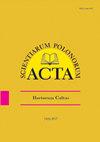Seed yield and weed infestation of pea (Pisum sativum L.), and soil properties in the systems of conventional and conservation agriculture
IF 0.7
4区 农林科学
Q4 HORTICULTURE
引用次数: 0
Abstract
Seed yield and weed infestation of pea as well as soil properties were evaluated in the systems of conventional (TA) and conservation (CA) agriculture. In both agricultural systems, pea was grown in crop rotation: potato – winter wheat – pea – winter barley. Shallow ploughing (10–12 cm) after previous crop harvest and pre-winter ploughing (20–25 cm) were performed, whereas a pre-sowing cultivation set was deployed in the springtime in TA. In CA, glyphosate was applied after previous crop harvest, and post-harvest residues were left on the filed surface (4.5 t ha–1). A cultivation-sowing set was used in the springtime, and pea was sown at the beginning of April. The study demonstrated that the agricultural systems tested had no significant effect on pea seed yield. A higher number and air-dry weight of weeds, and a higher weed species number were demonstrated in TA than in CA. Also, a higher number and air-dry weight of weeds were recorded in 2020 than in the other study years. Contents of organic C and total N in the soil and the number of earthworms were higher in CA than in TA.豌豆(Pisum sativum L.)的种子产量和杂草侵扰,以及传统农业和保护性农业系统中的土壤特性
在传统(TA)和保护(CA)农业系统中评估了豌豆的种子产量、杂草侵扰以及土壤特性。在这两种农业系统中,豌豆都是轮作种植的:马铃薯-冬小麦-豌豆-冬大麦。在前一次作物收获后进行浅耕(10-12厘米)和冬前耕(20-25厘米),而在TA的春季部署了播种前栽培装置。在CA,草甘膦是在前一次作物收割后施用的,收割后的残留物留在田地表面(4.5 t ha–1)。种植播种机在春天使用,豌豆在四月初播种。研究表明,所测试的农业系统对豌豆种子产量没有显著影响。TA的杂草数量和空气干重高于CA。此外,2020年的杂草数量与空气干重也高于其他研究年份。土壤中有机碳和总氮含量以及蚯蚓数量在CA中高于TA。
本文章由计算机程序翻译,如有差异,请以英文原文为准。
求助全文
约1分钟内获得全文
求助全文
来源期刊
CiteScore
1.30
自引率
14.30%
发文量
61
审稿时长
4-8 weeks
期刊介绍:
In Acta Scientiarum Polonorum Hortorum Cultus we publish original research papers and review articles containing new and significant information on broad aspects of horticulture and related disciplines. The papers are published in English only, in six issues yearly.

 求助内容:
求助内容: 应助结果提醒方式:
应助结果提醒方式:


